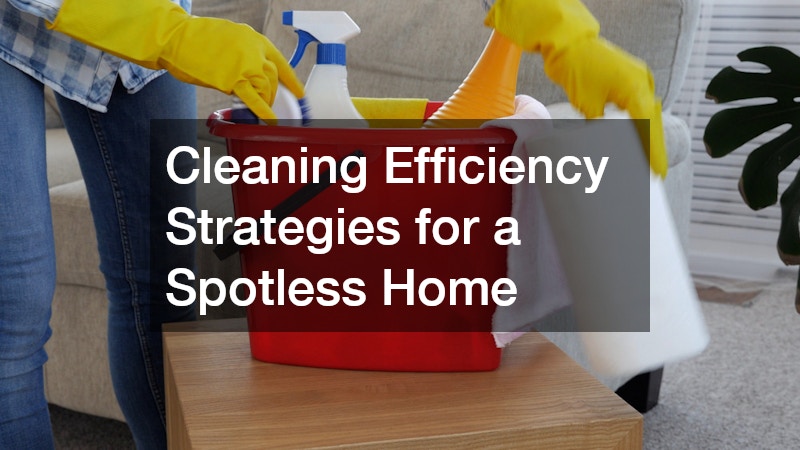Keeping a home spotless can sometimes feel like a never-ending task, especially when life gets busy and the mess piles up faster than you’d like. That’s where cleaning efficiency comes in — a set of smart strategies and techniques designed to help you clean faster, better, and with less stress. When you improve your cleaning efficiency, you’re not just saving time; you’re also creating a more pleasant living environment, one that supports your wellbeing and peace of mind.
Whether you’re a busy professional, a parent juggling multiple tasks, or just someone who wants to enjoy a clean home without spending all day cleaning, these strategies will help you work smarter, not harder. From choosing the right cleaning supplies, to what to consider before a dumpster rental, and even involving your family in the process, this article covers everything you need to boost your cleaning efficiency and enjoy a consistently tidy space.
Throughout the article, we’ll also touch on some related home services like air duct cleaning, pool cleaning, and environmental cleanup that can contribute to a healthier home and environment. By the end, you’ll have a solid game plan for cleaning efficiently and effectively, with practical tips you can start using today.
What Are the Most Effective Cleaning Supplies?

Essential Cleaning Supplies for Every Home
Before diving into routines and schedules, it’s important to start with the basics: your cleaning supplies. Having the right tools on hand is the foundation of cleaning efficiency. Some essentials include all-purpose cleaners, microfiber cloths, scrub brushes, sponges, and gloves. These basics tackle most common surfaces and messes with ease.
Eco-Friendly Cleaning Alternatives
Cleaning efficiency isn’t just about speed — it also involves being mindful of the environment. Choosing eco-friendly cleaning supplies can help reduce your carbon footprint without sacrificing performance. Compostable food containers, for example, are part of a growing movement towards sustainable household products.
Many cleaning companies now offer green-certified products that are free from harsh chemicals and safe for use around children and pets. Vinegar, baking soda, and lemon juice are popular natural alternatives that work well on many surfaces. Incorporating these options supports a healthier home and environment while keeping your cleaning routine effective.
How to Choose the Right Cleaning Supplies for Different Surfaces
Different surfaces require different care to avoid damage and maximize cleanliness. Wood floors, glass, stainless steel, and tile all need tailored products or techniques. For example, hardwood floors should be cleaned with pH-neutral products to preserve their finish, while glass surfaces benefit from streak-free cleaners.
How Often Should I Clean Different Areas of My Home?
Cleaning Schedule for High-Traffic Areas
High-traffic areas like the kitchen, bathrooms, and entryways tend to get dirty quickly and require frequent attention. Establishing a regular cleaning schedule for these zones is key to maintaining a spotless home without feeling overwhelmed.
For kitchens, daily wipe-downs of countertops and sinks prevent buildup, while bathrooms benefit from a few deep cleans per week to keep grime and bacteria at bay. Entryways, often a catch-all for dirt and debris, might need sweeping or vacuuming every couple of days.
Maintaining Less Frequently Used Spaces
Rooms that see less use, such as guest bedrooms or formal dining areas, don’t need as much frequent cleaning but should not be neglected. Monthly dusting, vacuuming, and surface cleaning can keep these spaces fresh and ready for use.
Paying attention to these areas on a consistent but less frequent basis prevents a massive cleanup later, helping maintain overall cleaning efficiency throughout the home.
Seasonal Deep Cleaning Tasks
Beyond regular upkeep, seasonal deep cleaning tackles the areas and tasks that accumulate dirt over time but don’t need constant attention. This includes cleaning behind appliances, washing windows, air duct cleaning, looking into dumpster rental, and pool cleaning if you have one.
Scheduling these tasks quarterly or seasonally breaks down large projects into manageable chunks and ensures your home stays in great condition year-round. Seasonal cleaning also supports environmental cleanup efforts by preventing buildup of dust, mold, or debris that can impact indoor air quality.
What Cleaning Routines Save the Most Time?
Daily Versus Weekly Cleaning Routines
Balancing daily and weekly cleaning tasks is a powerful way to boost cleaning efficiency. Daily routines typically focus on quick tasks like wiping down surfaces, doing the dishes, and tidying clutter. These small efforts prevent messes from turning into bigger projects.
Weekly routines involve more thorough cleaning such as vacuuming carpets, scrubbing bathrooms, and drain cleaning to prevent blockages. By assigning tasks to different days, you avoid burnout and maintain a steady rhythm that keeps your home spotless with less stress.
The ‘Clean As You Go’ Principle
One of the best ways to improve cleaning efficiency is adopting the ‘clean as you go’ mindset. This means tackling small messes immediately rather than letting them pile up. For example, rinsing pots while cooking or wiping splashes on the bathroom sink after use can save hours of scrubbing later.
Multitasking Cleaning Techniques
Multitasking might sound counterintuitive for cleaning, but with some planning, it can save significant time. For instance, running the dishwasher or washing machine while wiping down surfaces or vacuuming floors means you’re making the most of your time.
Using a cleaning company for larger projects like air duct cleaning or environmental cleanup can also free up your schedule, allowing you to focus on daily maintenance and smaller tasks.
How Can I Make Cleaning Less Overwhelming?

Breaking Down Cleaning Tasks Into Manageable Chunks
Cleaning an entire house in one go can feel overwhelming and lead to procrastination. Breaking tasks down into smaller, manageable chunks helps maintain motivation and efficiency.
You might focus on one room at a time or divide tasks by type, such as dusting one day and mopping the next. This approach aligns with cleaning efficiency by preventing burnout and making progress feel achievable.
Using a Cleaning Checklist for Motivation
A cleaning checklist provides a clear plan and tracks what’s done, which can boost motivation. Seeing tasks checked off one by one gives a sense of accomplishment that encourages continuation.
Digital or paper checklists tailored to your home’s needs can help ensure no areas are forgotten, from regular tasks like drain cleaning to less frequent jobs like pool cleaning.
Setting a Timer for Focused Cleaning Sessions
Using a timer can increase productivity by setting clear boundaries for cleaning sessions. Whether it’s 15, 30, or 60 minutes, focused cleaning within a set time keeps you on task and makes the work less tedious.
Timed sessions can turn cleaning into a game or challenge, helping maintain energy and focus for better cleaning efficiency.
What Are Some Tips for Decluttering Before Cleaning?
The Importance of a Clutter-Free Space
Decluttering is often the first step before effective cleaning. A clutter-free space is easier to clean because there are fewer obstacles and less surface area to manage.
Removing unnecessary items improves the overall look and feel of your home and can reduce dust accumulation, which helps with air duct cleaning and general environmental cleanup.
Step-by-Step Decluttering Process
Start decluttering by focusing on one area or category at a time, such as clothes, books, or kitchen items. Sort items into piles for keeping, donating, or tossing. This systematic approach prevents feeling overwhelmed.
Once clutter is reduced, cleaning becomes faster and more effective, improving your overall cleaning efficiency.
How to Decide What to Keep, Donate, or Toss
When deciding what to keep, consider how often you use an item and whether it adds value to your life or home. Items in good condition but no longer needed can be donated to help others and reduce waste.
Toss anything broken or unusable responsibly, keeping environmental concerns in mind. Compostable food containers, for example, are a great alternative to single-use plastics that contribute to landfill waste.
Are There Specific Techniques for Cleaning Different Surfaces?
Cleaning Glass and Mirrors
Glass and mirrors can show streaks and spots easily, so using the right technique is key for cleaning efficiency. Use a microfiber cloth paired with a solution of water and vinegar or a specialized glass cleaner. Wipe in a circular motion followed by vertical or horizontal strokes to avoid streaks.
Avoid paper towels which can leave lint and make cleaning take longer. Regularly cleaning glass surfaces not only keeps them clear but also brightens your home’s appearance.
Effective Methods for Hardwood Floors
Hardwood floors require gentle care to maintain their beauty and longevity. Sweep or vacuum regularly to remove dust and grit that can scratch the surface. When mopping, use a damp—not wet—mop with a pH-neutral cleaner designed for hardwood.
Avoid harsh chemicals or excessive water which can damage the wood finish. Maintaining hardwood floors efficiently helps prevent buildup that requires intensive cleaning or refinishing later.
Best Practices for Kitchen Appliances
Kitchen appliances are high-use areas prone to grease and grime buildup. For cleaning efficiency, wipe appliances daily with a damp cloth and mild detergent. For tougher stains, use baking soda paste or commercial cleaners safe for the appliance surface.
Regular cleaning of appliance vents, coils, and filters improves performance and safety. Hiring specialized plumbers or drain plumbers for appliance repairs or maintenance can complement your cleaning routine by addressing issues that interfere with hygiene.
How Can I Motivate Myself to Clean Regularly?

Creating a Cleaning Schedule
A cleaning schedule is a practical tool for staying consistent and motivated. By setting specific days for different tasks, you create a routine that becomes second nature over time.
Include a mix of quick daily tasks and deeper weekly or monthly chores. This balanced approach prevents tasks from piling up and reduces the effort needed for each cleaning session.
Reward Systems for Completing Cleaning Tasks
Incentivizing yourself can boost cleaning motivation. After completing tasks or sticking to your schedule for a week, reward yourself with something enjoyable—a favorite snack, leisure time, or a small purchase.
Positive reinforcement turns cleaning from a chore into a satisfying accomplishment, making it easier to maintain your cleaning efficiency.
Inviting Friends or Family for Cleaning Sessions
Turning cleaning into a social activity can make it more enjoyable and less of a burden. Inviting friends or family to help with a cleaning session can turn chores into fun, productive gatherings.
You can even turn it into a friendly competition or group project, which motivates everyone and speeds up the work.
What Role Does Organization Play in Cleaning Efficiency?
Organizational Tools to Enhance Cleaning
Using organizational tools like labeled bins, storage baskets, and shelves makes cleaning faster by reducing clutter and making items easier to find and put away.
Organizing areas like closets, kitchen cabinets, and laundry rooms supports cleaning efficiency by minimizing the time spent searching for supplies or clearing surfaces.
How to Organize Cleaning Supplies
Store your cleaning supplies in a portable caddy or designated closet area for easy access. Group similar items together — for example, all bathroom cleaners on one shelf and kitchen cleaners on another.
The Benefits of a Tidy Space on Cleaning Motivation
A tidy, organized space naturally motivates cleaning. When your home looks orderly, you feel more inspired to maintain that standard.
Decluttering and organizing not only streamline cleaning but also contribute to a more relaxing and inviting environment, boosting overall wellbeing.
What Are Some Time-Saving Cleaning Gadgets or Tools?
Highlighting Popular Cleaning Tools on the Market
Modern cleaning gadgets can significantly enhance cleaning efficiency. Popular tools include cordless vacuum cleaners, steam mops, microfiber dusters, and extendable scrub brushes.
These devices reduce physical effort and speed up tasks, making it easier to maintain a clean home regularly.
Innovative Gadgets That Make Cleaning Quicker
Robotic vacuum cleaners and mops have gained popularity for their ability to clean floors autonomously. UV sanitizers and handheld steam cleaners are other innovations that offer deep cleaning with less manual labor.
Incorporating these gadgets into your routine can save time and keep your home cleaner with less effort.
Evaluating the Effectiveness of Robot Vacuums
Robot vacuums vary in quality and capabilities. While some models handle pet hair, stairs, and multiple floor types well, others may struggle with complex layouts or heavy dirt.
For cleaning efficiency, choose a robot vacuum that suits your home’s specific needs. Pairing robot vacuums with traditional cleaning tools ensures thorough cleanliness without excessive time investment.
How Can I Involve My Family or Housemates in Cleaning?

Assigning Cleaning Tasks to Family Members
Sharing cleaning responsibilities lightens the load and builds collective investment in a tidy home. Assign age-appropriate tasks to each family member or housemate.
Clear roles help avoid confusion and ensure all areas get regular attention. This collaboration improves cleaning efficiency by distributing work evenly.
Making Cleaning a Fun Group Activity
Turning cleaning into a game or social event can motivate participation. Play upbeat music, set timers for challenges, or reward team efforts with treats or outings.
Making cleaning fun encourages regular involvement, builds teamwork, and makes the process less of a chore.
Establishing a Chore Chart to Track Contributions
A chore chart helps keep track of who does what and when. Whether digital or on paper, it promotes accountability and fairness.
Seeing completed chores visually can motivate everyone to contribute consistently, improving the home’s overall cleanliness and cleaning efficiency.
Conclusion
Cleaning efficiency is more than just a goal — it’s a mindset and a set of practical habits that transform your approach to keeping a spotless home. By carefully selecting cleaning supplies, maintaining consistent schedules, and breaking tasks into manageable chunks, you can save time and reduce stress. Incorporating eco-friendly choices like compostable food containers and supporting services, such as hiring a drain plumber or environmental cleanup professional, can enhance not only your home but also the environment.



